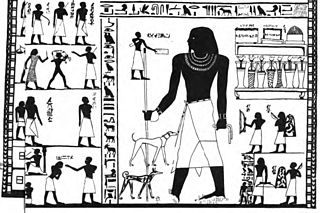 W
WAmenemhat, often reported with his short form Ameny (Jmnjj), was an ancient Egyptian "Overlord of the Oryx nome" and chief priest during the reign of pharaoh Senusret I of the 12th Dynasty.
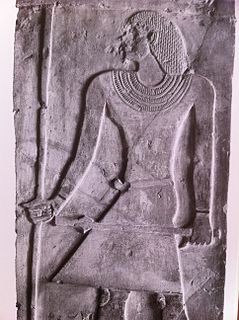 W
WAnkhtifi was a nomarch of Hierakonpolis and a supporter of the pharaoh in Herakleopolis Magna, which was locked in a conflict with the Theban based 11th Dynasty kingdom for control of Egypt. Hence, Ankhtifi was possibly a rival to the Theban rulers Mentuhotep I and Intef I. He lived during the First Intermediate Period, after the Egyptian Old Kingdom state had collapsed, and at a time when economic hardship, political instability, and foreign invasion challenged the fabric of Egyptian society.
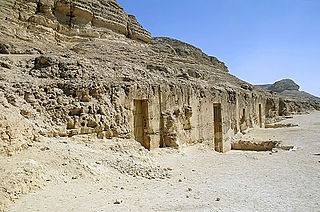 W
WBaqet III was an ancient Egyptian official and Great Chief of the Oryx nome during the 11th Dynasty in the 21st century BCE. Apart from the position of governor of the entire nome, Baqet III also held the titles haty-a, treasurer of the king of Lower Egypt, confidential friend, true royal acquaintance, and mayor of Nekheb.
 W
WDjefaihapi was an ancient Egyptian official during the reign of pharaoh Senusret I of the 12th Dynasty. In literature, his name is found written in many other variants such as Hepzefa, Hapidjefa, Hapdjefai, and Djefaihap.
 W
WDjehutihotep was an ancient Egyptian nomarch of the fifteenth nomos of Upper Egypt during the twelfth dynasty, c. 1900 BC.
 W
WDjehutynakht, tentatively identified with Djehutynakht IV or Djehutynakht V, was an ancient Egyptian "Overlord of the Hare nome" during the very end of the 11th Dynasty or the early 12th Dynasty. He is well known for his painted outer coffin now exhibited in the Museum of Fine Arts, Boston along with his other grave goods.
 W
WGegi as an Ancient Egyptian high official who lived at the end of the Old Kingdom in the 6th Dynasty around 2300 BC, although it is not possible to provide an exact date. Gegi is known from his false door and six statues. They were found at Saqqara and entered the Egyptian Museum in 1884 where they are still housed. They must come from his tomb. The exact findspot of his burial is unknown. On his monuments, Gegi bears different titles, the most important being overlord of the Thinite nome (Ta-wer). He was therefore nomarch of the province. Gegi was also overseer of priests of Onuris. The latter god was the main deity at Thinis.
 W
WHeqaib, also Hekaib or Hekayeb, was an ancient Egyptian nomarch of the 1st nomos of Upper Egypt under king Pepi II Neferkare, towards the end of the 6th Dynasty. He was also an officer in charge of military expeditions in Nubia.
 W
WHormeni was an ancient Egyptian dignitary who officiated at the beginning of the Eighteenth Dynasty.
 W
WIdy was an important Ancient Egyptian official in the Eighth Dynasty, at the beginning of the First Intermediate Period. He was the son of Shemay, who is also known from several monuments and decrees from Koptos. His mother was the king's daughter Nebet. Idy appears on many royal decrees found at Koptos. There he bears the important title of a vizier, but was also overseer of Upper Egypt and overseer of priest and count. The decrees are dated under king Neferkauhor and Neferirkare. One decree is addressed to Shemay and dates under Neferkauhor. It reports the appointment of Idy to the overseer of Upper Egypt. A second one mentions affairs in the temple of Min at Koptos. In a third decree Idy bears the titles of a vizier. In the decree, the king protects the statues and the funerary cult of Idy. The decree is dated under king Neferirkare, who was the successor of Neferkauhor. It seems that Idy took over many positions that his father hold before.
 W
WIntef, whose name is commonly accompanied by epithets such as the Elder, the Great or born of Iku, was a Theban nomarch during the First Intermediate Period c. 2150 BC and later considered a founding figure of the 11th Dynasty, which eventually reunified Egypt.
 W
WSehertawy Intef I was a local nomarch at Thebes during the early First Intermediate Period and the first member of the 11th Dynasty to lay claim to a Horus name. Intef reigned from 4 to 16 years c. 2120 BC or c. 2070 BC during which time he probably waged war with his northern neighbor, the Coptite nomarch Tjauti. Intef was buried in a saff tomb at El-Tarif, known today as Saff el-Dawaba.
 W
WKaikhenet was an ancient Egyptian local governor in the 10th Upper Egyptian province; the latter called Wadjet in Egyptian language. Kaikhenet lived at the beginning of the Fifth Dynasty and is known from his decorated rock cut tomb at Hemamieh. Decorated rock cut tombs are very rare in the Egyptian province before the end of the Fifth Dynasty. The tombs at Hemamieh are an exception. They belong to the earliest ones in the provinces.
 W
WKhety was an ancient Egyptian local governor of the Oryx nome in Middle Egypt in the Twelfth Dynasty. He is only known from his decorated tomb chapel at Beni Hasan. In the decoration of his tomb chapel appear several inscriptions providing the name and titles of Khety. He was great overlord of the entire Oryx nome. This is the main title of the local governors of the Oryx nome. Other titles include count (Haty-a), royal sealer, sole friend, king's acquaintance, who is in the chamber, who belongs to Nekhen and overlord of Nekheb, but also overseer of troops at all secret places. Not much is known about his family. His father was a person called Baqet, his wife was called Khnumhotep and there is one son attested with the name Khety. Naguib Kanawati wonders whether Khety was the son of Baqet III. The latter's tomb and those of Khety share the same plan and are close to each other.
 W
WKhety II was an ancient Egyptian nomarch of the 13th nomos of Upper Egypt during the reign of pharaoh Merykare of the 10th Dynasty.
 W
WMeryibre Khety, also known by his Horus name Meryibtawy, was a pharaoh of the 9th or 10th Dynasty of Egypt, during the First Intermediate Period.
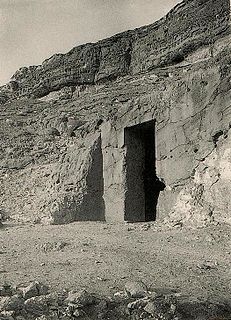 W
WKhnumhotep I was an ancient Egyptian Great Chief of the Oryx nome during the reign of Pharaoh Amenemhat I of the 12th Dynasty, Middle Kingdom.
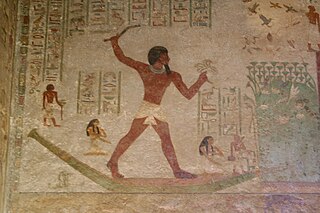 W
WKhnumhotep II was an ancient Egyptian Great Chief of the Oryx nome during the reign of pharaohs Amenemhat II and Senusret II of the 12th Dynasty, Middle Kingdom. He is well known for his tomb at Beni Hasan and its decorations.
 W
WKhubau was an ancient Egyptian high official who lived at the end of the Old Kingdom in the 6th Dynasty around 2300 BC. He might date under king Pepi II or shortly after. Khubau is known from his tomb at Saqqara close to the Pyramid of Pepi II. His proper tomb was found by Gaston Maspero further elements, including two small obelisks and a small stela were excavated by Gustave Jéquier
 W
WKhui was an ancient Egyptian kinglet during the early First Intermediate Period. Khui may have belonged to the Eighth Dynasty of Egypt, as Jürgen von Beckerath has proposed, or he may instead have been a provincial nomarch who proclaimed himself king.
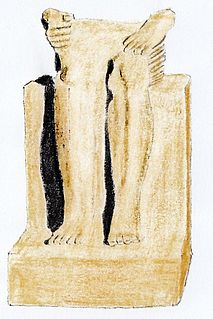 W
WMentuhotep I may have been a Theban nomarch and independent ruler of Upper Egypt during the early First Intermediate Period. Alternatively, Mentuhotep I may be a fictional figure created during the later Eleventh Dynasty, which rose to prominence under Intef II and Mentuhotep II, playing the role of a founding father.
 W
WMesehti was an ancient Egyptian nomarch of the 13th nomos of Upper Egypt around 2000 BCE, during the 11th Dynasty. He also was seal-bearer and overseer of the priests of Wepwawet.
 W
WNetjernakht was an Ancient Egyptian official known from his tomb chapel at Beni Hasan in Middle Egypt. He lived most likely in the Twelfth Dynasty. His exact date and position are disputed.
 W
WSarenput I was an ancient Egyptian official during the reign of pharaoh Senusret I of the 12th Dynasty.
 W
WSarenput II, also called Nubkaurenakht was an ancient Egyptian nomarch during the reign of pharaohs Senusret II and Senusret III of the 12th Dynasty.
 W
WShemay was an ancient Egyptian official and later vizier toward the end of the 8th Dynasty during the First Intermediate Period, mainly known for being the beneficiary of most of the Coptos Decrees. His career has been interpreted as a glaring sign of the extreme weakness of the central power, forced to bestow great privileges to maintain the loyalty of powerful local governors. Shemay is buried in a mudbrick mastaba just south of Coptos.
 W
WSobeknakht II was an ancient Egyptian local Governor at El-Kab and a supporter of the Theban 16th or 17th Dynasty during the Second Intermediate Period.
 W
WTefibi was an ancient Egyptian nomarch of the 13th nomos of Upper Egypt during the 10th Dynasty. In addition, he also was hereditary prince, count, wearer of the royal seal, sole companion and high priest of Wepwawet. The main source about his life came from his biography, inscribed on the "tomb III" in Asyut.
 W
WUkhhotep II was an ancient Egyptian official during the reign of pharaoh Senusret I of the 12th Dynasty.